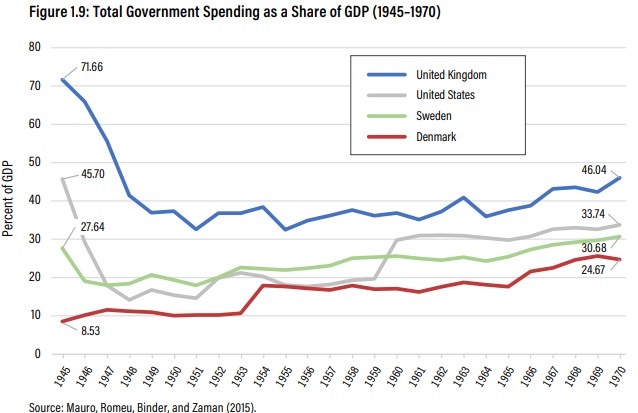When I ask my leftist friends to identify a nation that got rich with big government, the knowledgeable ones try to change the subject.
The ones who are not well informed will oftentimes cite Denmark.
It is true that Denmark has a big and expensive government.
And it also is true that Denmark is a rich nation by world standards (though well behind the United States).
But it is not true that Denmark became a rich country with big government.
Instead, it got rich when government was small.
I’ve made that point before, but let’s take a deeper look at that issue.
The Fraser Institute just published The Free Enterprise Welfare State: A History of Denmark’s Unique Economic Model. The first chapter, authored by Lars Christensen, Matthew Mitchell, and Steven Globerman, includes some fascinating fiscal history about Denmark.
This chapter examines the growth of the Danish economy during the last 150 years… A strong commitment to classical liberal economic policies aimed at enhancing the rule of law and minimizing the role of government in the economy was at the heart of Denmark’s economic development. The late 1800s and early 1900s marked a period of primarily laissez faire economic policies for the country. …Details about government spending provide one indication of the government’s limited role in the economy. Figure 1.3 shows central government spending as a share of GDP in the 1870s (when available) and in 1929 for five European nations. Not only did Denmark spend significantly less than others as a share of GDP, but its spending as a share of GDP changed very little over this 60-year period.
Here’s the aforementioned Figure 1.3, showing that the fiscal burden in Denmark was tiny during the period when the country went from agricultural poverty to middle-class prosperity.

Keep in mind that these were also years when Denmark had almost no redistribution.
Its welfare state was smaller than what Hong Kong has today.
The authors then explain that government was still small at the end of the 1930s.
Notwithstanding increased government spending on social and public works programs, the size of government in Denmark was still limited at the end of the 1930s (see figure 1.6) and there remained a broad political consensus that the Danish economy should be based on free market principles and free trade. Even though there had been a gradual shift towards more income redistribution, the role of government in the economy remained limited.
Here is Figure 1.6.
You can see that the burden of government spending is higher than it was in 1870 and 1929, but still below 10 percent of GDP.

By way of comparison, the spending burden in Denmark in 1938, measured as a share of GDP, was only about half the size of government today in “small-government” jurisdictions such as Singapore and Taiwan.
The relatively good policy continued for a couple of decades after World War II.
..the size of the government, measured as a percentage of GDP, was actually lower in Denmark and Sweden than it was in the United States and the United Kingdom throughout the 1950s, ’60s, and ’70s, as shown in figure 1.9. At that time, neither Denmark nor Sweden had the kind of universal welfare states that we are familiar with today. In fact, both countries stayed relatively faithful to the traditional liberal economic values that had fuelled their economic expansions nearly a century before. As a result, Denmark became wealthy before substantially increasing government spending and taxes to support the large welfare state we associate with the country today.
Here’s Figure 1.9, showing that Denmark (as well as Sweden) were more frugal than the United States as recently as 1970.

Let’s conclude with bad news.
The welfare state in Denmark dramatically expanded starting in the late 1960s.
…it was during the late 1960s that things began to change. … from 1965 to 1980, total taxes as a share of Denmark’s Gross Domestic Product increased from 29 percent to over 40 percent (see figure 1.10). The two most important categories of central government spending financed by the increased tax revenues were social services and education. …the country has had some major policy setbacks, most notably the major macroeconomic policy mistakes of the 1970s when an explosion of government spending contributed to rapidly increasing wages, serious structural unemployment, relatively rapid price increases, and a balance of payments crisis.
The country has tried to claw back some of that excess spending in recent years, but the public sector remains an enormous burden.
Fortunately, the country follows very pro-market policies in other areas such as trade, regulation, and monetary policy.
So the net result is that Denmark rivals the U.S. in terms of overall economic liberty (and is much better than Hungary, a nations that some American conservatives greatly admire).



